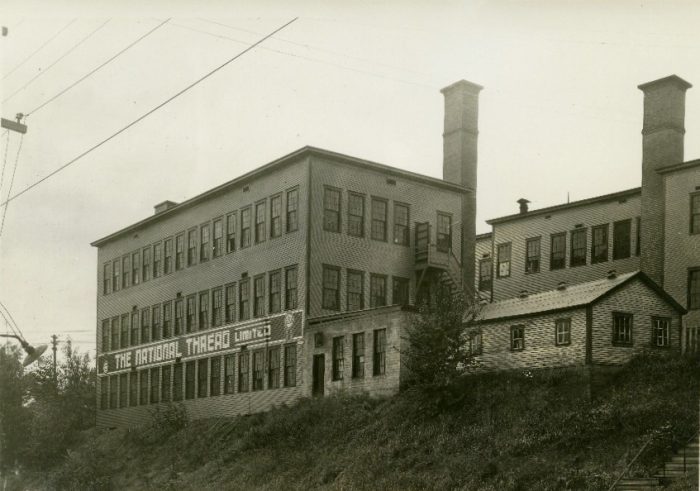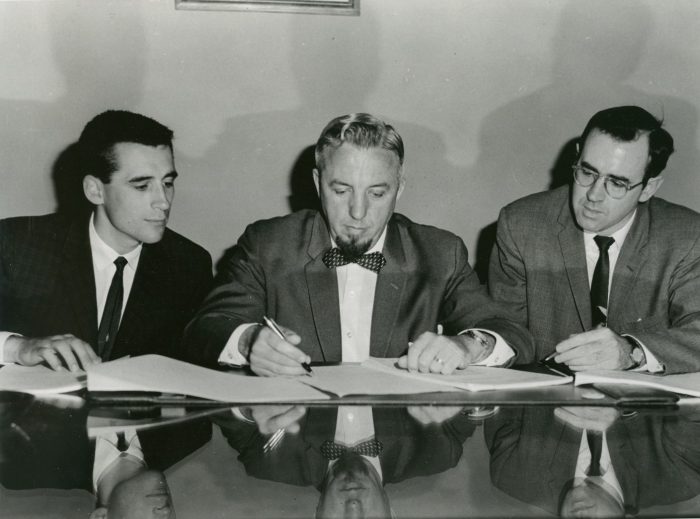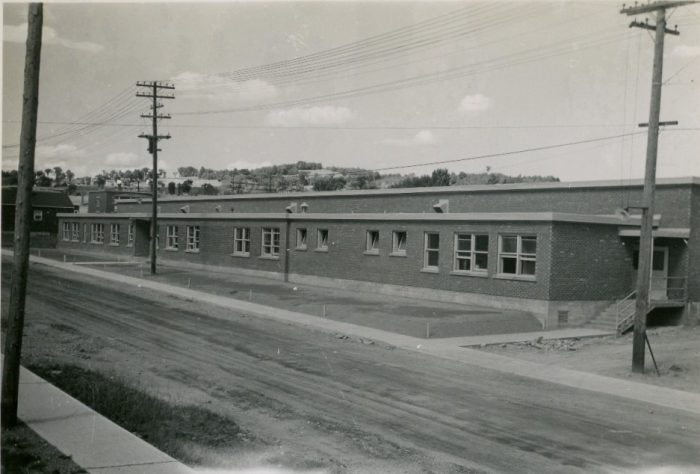

Share
Toil, Tears, Trials and Tribulations: Recollections of the National Thread Limited
February 2nd, 2023
By Jazmine Aldrich
In a brief history written in the late-1960s, Freeman Clowery reflects on his time spent working for The National Thread Limited in Sherbrooke: “How well I recall these days of toil, sweat, and tears; of trials and tribulations, of success and defeat, of disappointments and accomplishments.” Clowery’s time with the company spanned its Golden Age in the 1950s and 1960s, until its collapse in 1971. He observed the company’s rise and fall from the perspective of its Officer Manager and Secretary-Treasurer.
The National Thread Ltd. succeeded the Ideal Thread Limited, which began its operations in Montreal in 1939. Its directors, J. Edgar Genest of Sherbrooke and J.-A. Archambault of Montreal, spearheaded efforts to relocate the thread manufacturing company to Sherbrooke in 1941.
Negotiations with the City of Sherbrooke spanning the first quarter of the year resulted in the renovation of a municipally-owned factory on Laurier Avenue previously occupied by the Modernistik Company and the Dufferin Jack Company. The Ideal Thread Ltd. agreed to lease the building from the City if the City would pay for repairs to the factory. The renovations included the addition of a second story, a boiler room, and a new elevator, but the company’s promise for growth was enough to justify the expenses. A $14,500 municipal building permit was issued in May 1941.
In April 1941, La Tribune reported that while renovations would soon be underway on the Laurier Avenue factory, The Ideal Thread Ltd. was to be absorbed by another, unnamed company but would keep its directors. The National Thread Limited was incorporated on May 1, 1941. The Ideal Thread Ltd. surrendered its charter and dissolved on February 25, 1942.
Business grew for The National Thread Ltd. over the 1940s with its production of domestic and industrial thread and shoelaces. By 1952, the company had distribution branches across Canada. While American competitors reduced National Thread’s international sales, the Canadian market was still a strong one for the company. 1952 also saw a moment of transition: founder and President J. Edgar Genest was ceding control of the company to the capable hands of his only son and National Thread’s General Manager, Claude Genest.
In his memoir, Clowery recalls the company’s Charter President, J. Edgar Genest, in the following way: “He was a man of unlimited forethought and confidence, but, in the years that I worked with him, his most prominent characteristic was an unshakeable faith in his son.” J. Edgar retained the company’s presidency until his death in 1959, at which point Claude Genest assumed the presidency.
Claude joined in his father’s business in 1944 after receiving his discharge from the Canadian Army. Clowery also compliments the younger Genest, writing that he: “[…] has many inherited characteristics. His influence on the operations was felt from the very start, but the building of the new, modern mill was his trademark, a study of youth with a vision, as against age with security.”
The new mill at 370, 10th Avenue in Sherbrooke was a $250,000, 30,000-square-foot, single-story factory. Construction took eight months and was completed in February 1952. Several local businesses outfitted the new factory with everything from plumbing to office supplies. It was expected to employ 125 men and women, and to double the company’s production output. Clowery recalls this new facility as “an up-to-date establishment, with planned layout for optimum efficiency, with room for growth, to meet the challenge of the future,” but also recalls the financing, manufacturing controls, and administrative changes that accompanied this expansion.
Despite its early success, The National Thread Ltd. closed the doors of its Sherbrooke factory on March 4th, 1971, leaving 80 employees to find work. Claude Genest blamed foreign competition and increased production costs, especially wages. The signing of a collective agreement with the Union des Ouvriers du Textile D’Amérique in 1961 brought a salary increase for the company’s workers, paid holidays, and overtime pay, lending credence to Genest’s explanation. In its final year, National Thread’s workforce was reduced by nearly half. Genest maintained that the company’s Sherbrooke operations needed considerable mechanization to increase profit, which shareholders were not interested in funding given the economic climate of the time. The factory closed, along with another chapter of Sherbrooke’s industrial history.

Photo credit : P244 Freeman Clowery Collection
The first National Thread Ltd. factory located on Laurier Avenue in Sherbrooke.

Photo credit : P244 Freeman Clowery Collection
Union des Ouvriers du Textile D'Amérique (UOTA) and the National Thread Ltd. representatives signing the collective agreement in 1961. Freeman Clowery is in the centre, with UOTA representatives Gilles Courchesne to the left and Robert Dean to the right.
